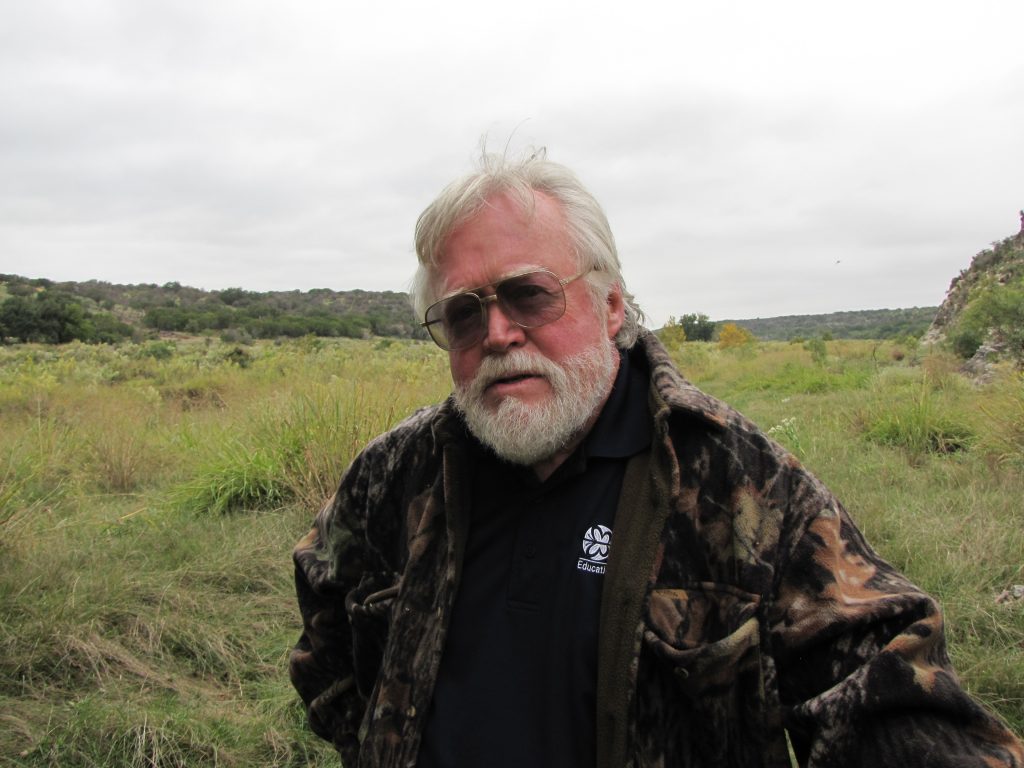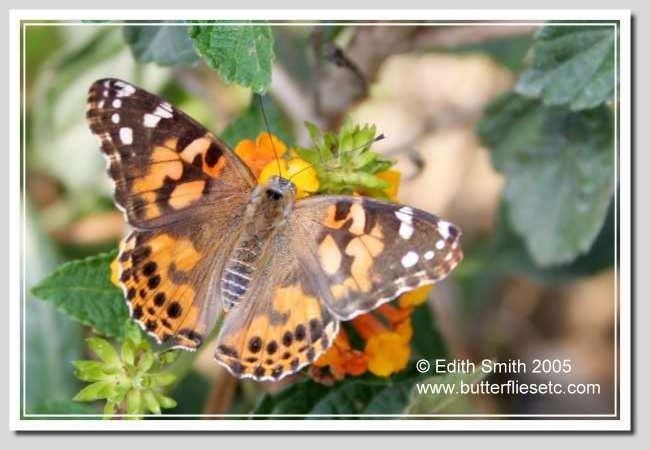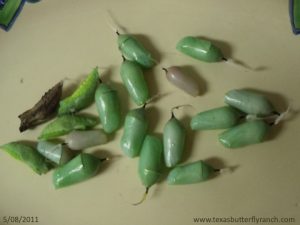Dr. Chip Taylor, the founder of Monarch Watch at the University of Kansas at Lawrence, will address almost 100 professional butterfly breeders this week at their annual conference in San Antonio. Dr. Taylor oversees the citizen scientist tagging program that tracks the Monarch butterfly migration from Mexico to Canada and back each year.

Monarch Watch founder Dr. Chip Taylor on the Llano River in the Texas Hill Country last year. Dr. Taylor will be in town this week to address the International Butterfly Breeders and the Association for Butterflies combined annual convention. Photo by Monika Maeckle
The conference, a combined effort of the International Butterfly Breeders’ Association (IBBA) and the Association for Butterflies (AFB), will bring professional butterfly breeders and butterfly enthusiasts–mariposistas, as I like to call them–to the Drury Inn at La Cantera Parkway in San Antonio, November 7-10. The far-flung butterfly fans will gather from as far away as Costa Rica and as close as Rockport, Texas for education, networking and fun.

Painted Lady butterflies and Monarchs are the “money crops” of the commercial butterfly breeding industry. Photo courtesy Edith Smith, Shady Oak Butterfly Farm
This year’s convention commemorates the IBBA’s 15th year and the founding of the multimillion dollar commercial butterfly breeding industry. The butterfly breeding business supplies butterflies to schools, museums, zoos and exhibits for education and scientific purposes. Live butterflies also are tapped to commemorate weddings, funerals and other special occasions.
The conference is open to the public. “Butterfly beginners are welcome,” said Kathy Marshburn of Vibrant Wings Butterflies in South Carolina and Texas. Marshburn, who serves as IBBA president and conference organizer, pointed to sessions on butterfly gardening, parasites and how to raise butterflies as worthy investments of beginners’ time.

Getting a caterpillar to the chrysalis stage can be challenging. Come learn the tricks of the trade from the professionals. Photo by Monika Maeckle
This will be my fourth IBBA convention. Back in 2010, I attended my first in the unlikely venue of Las Vegas. It set me off on a learning streak.
By the end of 2011 I thought I might want to raise butterflies full-time, as a profession. I quit my corporate marketing position, applied for USDA permits to ship butterflies to the 48 contiguous states and cultivated my membership in the IBBA.
While my fantasy of becoming a professional breeder lasted only five months (Raising butterflies is too stressful–I’d rather meet copywriting deadlines!), it has been a great investment in my butterfly education. I’ve learned an immense amount and continue to enjoy the friendship and enlightenment offered by my professional butterfly breeder friends.
Most impressive is the amazing generosity and knowlege-sharing of this fine group of ferociously independent professionals, the majority of whom chose this career because of a sheer love of butterflies.
If you want to learn or refine your butterfly rearing or caterpillar wrangling, I strongly encourage you to check out the program. Depending on how many sessions you attend, cost ranges from $35 to hear Dr. Chip Taylor at the keynote dinner on Saturday night to $50 for a day pass. Or you can spring for the whole three-day conference, which includes meals, for $95–truly a butterfly bargain. You can register online.
The conference kicks off on Thursday with a “butterfly hunt” led by Todd Stout, of Raising Butterflies, a butterfly breeder and lepidopterist who has scouted some of the best places to see butterflies in San Antonio.
“We’re looking forward to seeing lots of butterflies, including common mestra, variegated fritillary, lysine sulphurs, sleepy orange, and dainty sulphure,” Stout relayed via email.
You can learn how to raise Monarchs and Painted Ladies, what to plant in a butterfly garden, enter “The Secret World of the Monarch Metamorphosis,” take classes on pests and parasitoids, and meet the authors of more than half a dozen books on rearing, chasing, and gardening for butterflies. Oh, and if you’re a devotee of butterfly oriented jewelry or merchandise, don’t miss the silent auction. Vendors of butterfly paraphernalia, breeding supplies, books and more will also be on hand during breaks.
The conference will peak on Saturday evening when Dr. Taylor addresses the group. Taylor has been involved in Monarch conservation for decades and is synonymous with the citizen scientist tagging program which he and his team oversee each year. He’ll tackle the complex topic of the Monarch migration in the context of climate change.
“All of us face the challenge to engage in conservation of pollinator habitat,” said Dr. Taylor by phone. “Monarchs are the poster child and the threats to their migration are symbolic of what we’re doing to pollinators in this country–ignoring the fact that 80% of our crops require insect pollination and 70% of our vegetation, period, requires insect pollination. We do this at our own peril.”
Hmm….is there a role in there for professional butterfly breeders? Can’t wait to find out.
Take a look at the program. I look forward to seeing you there.
More posts like this:
- Founder of the Monarch Roosting Spot Lives a Quiet Life in Austin, Texas
- Yo Soy Mariposista!
- Butterfly Farmer Edith Smith Keeps it All in the Family at Shady Oak Butterfly Farm
- How to Raise Monarch Butterflies at Home
- Part II: More Tips on Raising Monarch Caterpillars and Butterflies at Home
- FOS Monarch Lays Eggs in San Antonio Urban Garden
- Tropical Milkweed: To Plant it or Not is No Simple Question
- Oh Those Crazy Chrysalises: Caterpillars in Surprising Places
- Butterfly FAQ: Is it OK to Move a Chrysalis? Yes, and here’s how to do it
- Should You Bring in a Late Season Caterpillar into Your Home?
Like what you’re reading? Don’t miss a single post from the Texas Butterfly Ranch. Sign up for email delivery, like us on Facebook, or follow us on Twitter, @monikam.


I had the opportunity to attend a week long workshop with Dr. Karen Oberhauser at the NC Museum of Natural Sciences quite a few years ago and it was one of the best workshops I ever done.
Too late to plan for this year, when will the date for next year be published..Thanks, Lisa